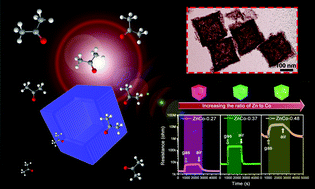ZnxCo3−xO4 bimetallic oxides derived from metal–organic frameworks for enhanced acetone sensing performances†
Abstract
Spinel type cobalt-based (Co-based) semiconducting oxides are promising materials for chemical sensors, owing to their excellent catalytic activity and oxygen adsorption properties. Herein, more effective cobalt–zinc (Co–Zn) bimetallic oxides are prepared by partial isomorphic substitution of Zn in Co-based zeolitic imidazolate framework (ZIF) precursors and a subsequent pyrolysis method. In order to optimize the components, the Zn content was controlled in metal–organic frameworks (MOFs) during the growth process. When tested as an acetone sensing layer for gas sensors, the prepared ZnxCo3−xO4 hollow nanocages composed of nano-sized building blocks exhibited excellent sensing performances with high response, good selectivity and excellent stability. An in-depth study reveals that the enhanced sensing ability can be ascribed to the “composition–structure” synergistic effect, including more oxygen vacancy, increased active sites, large specific surface area and porous feature. This work can open up new opportunities for the rational synthesis and design of bimetallic oxide sensing materials with ultrasensitive sensing performances targeted for acetone gas detection.



 Please wait while we load your content...
Please wait while we load your content...